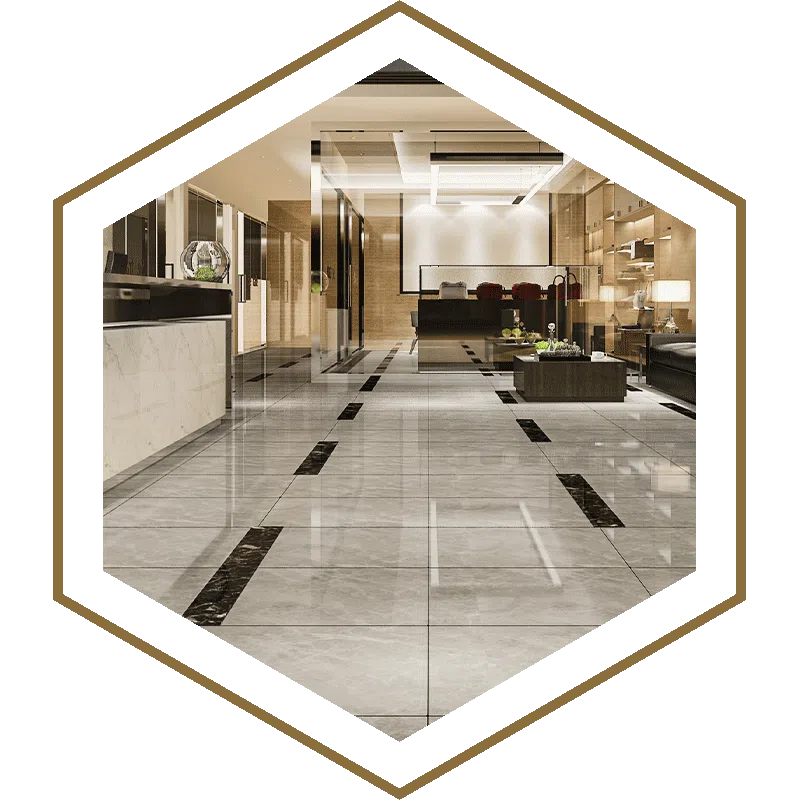The ceramic industry has developed exponentially in recent years thanks to the progressive evolution of some specific processes and products. These products (such as inks, grits, glazes, digital effects, etc …) have to be developed according to the requirements of the current technologies available on the market and they are essential for maintaining the high quality of the finished ceramic products.
Grits and inks are two fundamental components for ceramic producers. These two “ingredients” make it possible to have very rich products with an important technical and aesthetic value.
Ceramic grits
Specifically, ceramic grits are a combination of chemical technologies at the service of the beauty of the product.
The grit is made up of glass particles, with a precise particle size distribution, which are applied on a ceramic surface to get different effects.
What distinguishes the different ceramic grits is not only the particle size distribution, but also the origin of the raw materials and the composition. The composition significantly influences the chemical-physical properties of the glass in terms, for example, of colors yield, temperatures, characteristics, thermal expansion coefficient values, presence of porosity, etc …
To get the final effect required, a ceramic company often does not use a single grit, but mixtures of different grits to modulate the properties of the final glass layer.
The inks
Ceramic inks, in particular digital ones, are fundamental for coverings and floors and give the ceramic piece particular and unique aesthetic effects.
The final yield given by the inks, however, is the result of a preventive study within the digital research centers of manufacturers and suppliers of raw materials for ceramic companies, the beating heart of innovation in the sector.
The inks intended for digital technology, whether solvent-based or water-based, are designed in order to get the right balance of parameters and thus allow the best possible performance.
News at Sicer: HP full colored glass calibrated grits and Custom SCD2000 inks, the superheroes of color!
Digital R&D Lab and Technology Lab of Sicer are constantly in turmoil and looking for high-performance news for their customers.
This year, the manufacturer and supplier of raw materials for ceramic companies recently presented two new products that will expand the already supplied range of industrial products for floors and walls.
NEW HP FULL COLORED GLASS CALIBRATED GRITS AND MICROGRITS FOR PORCELAIN STONEWARE
This new series of grits has been carefully designed to ensure absolute color stability and intensity within the ceramic glass. These materials are water repellent and do not fade when diluted in water.
HP grits can be mixed with various neutral grits depending on the desired ceramic effect and color.
The HP full colored glass calibrated grits are available in 9 colors with 2 different grain sizes (.29 and .49).

The key features of this exclusive series are:
- Color intensity and depth
- Color stability
- Soft non-reflective effect
- Vitrified and water repellent color
- Possibility of generating customized mixtures with colored and neutral grits of the same particle size (HPX series).
Read the technical data sheet of HP full colored glass calibrated grits.
CUSTOM SCD2000 DIGITAL INKS FOR THE PERFECT FOUR-COLOR
In the traditional four-color ceramic process, Cyan, Red Brown, Honey/Yellow and Black are used, that is the four basic colors with which to get a wide variety of colors.
Sicer, however, has studied and created a new range of digital inks that offer the possibility of composing the traditional four-color process, choosing between 4 different combinations, to get a much more broad and intense color gamut than the traditional one.
Let’s talk about the CUSTOM SCD2000 series.
The color intensity of SCD2000 digital inks reaches up to + 30% / 40% compared to current standards.
The result?
- More intense colors
- Warm yellows
- Wide variety of greens
- Wide range of red-orange tones
All CUSTOM SCD2000 inks can be produced both in .E base (ester base) and .LE base (ECO solvent base) with low emission.
Read the technical data sheet of the CUSTOM SCD2000 series inks.
Sicer, after launching these new series of ceramic grits and inks, has also renewed and improved its product portfolio to guarantee customers an always complete and high quality offer.
Black Diamond solution
Sicer’s Technology Lab has studied the exclusive solution to create glossy lapped products on absolute black graphics.
The perfectly compact and transparent glass obtained with the grits of the Black Dry-Lux series, together with the black ink SCD071E or SCD1071LE, guarantees results without compromise: brilliance, resistance, purity!
Gran Lux solution
Another solution studied by the Technology Lab of the manufacturer and supplier of raw materials for ceramic companies is Gran Lux, a series of grits for wet applications for mirror lapping.
Gran Lux supports the Gra Dry-Lux series for dry application and completes the range of grits designed to get ultra-bright, transparent, compact and porosity-free honed surfaces.
In this context, and the new products presented, Sicer’s goal for its customers is clear:
“We create emotions and we have absolutely no plans to stop it.”
Sicer SpA
Frequently asked questions
Ceramic grits are glassy materials used to give aesthetic and protective effects to ceramic surfaces. Ceramic inks, on the other hand, are mainly used for digital decoration, offering intense colours.
HP grits are coloured cast grits that offer colour intensity, stability, and water-repellent resistance. They are available in different grit sizes and can be mixed to achieve various colour effects.
Grits can be applied dry or wet. Dry application is suitable for thick effects and marked textures, while wet application ensures an even distribution, ideal for smooth and polished surfaces.
Digital application of grit glue allows grits to be positioned precisely, confining their use to only the desired areas of the design, thus reducing material consumption and improving production efficiency.










